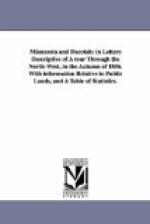Such are some of the geographical outlines of the extensive domain which will be soon organized as a new territory.
What will it be called? If the practice hitherto followed of applying to territories the names which they have been called by their aboriginal inhabitants is still adhered to, this new territory will have the name of Dacotah. It is the correct or Indian name of those tribes whom we call the Sioux; the latter being an unmeaning Indian-French word. Dacotah means “united people,” and is the word which the Indians apply to seven of their bands.[1] These tribes formerly occupied the country south and south-west of Lake Superior; from whence they were gradually driven towards the Missouri and the Rocky Mountains by their powerful and dreaded enemies the Chippewas. Since which time they have been the acknowledged occupants of the broad region to which they have impressed a name. Several of the tribes, however, have crossed the Missouri, between which and the Rocky Mountains they still linger a barbaric life. We may now hope to realize the truth of Hiawatha’s words:—
“After many years of warfare,
Many years of strife and bloodshed,
There is peace between the Ojibways
And the tribe of the Dacotahs.”
[1 The following description of the Dacotahs is based on observations made in 1823. “The Dacotahs are a large and powerful nation of Indians, distinct in their manners, language, habits, and opinions, from the Chippewas, Sauks, Foxes, and Naheawak or Kilisteno, as well as from all nations of the Algonquin stock. They are likewise unlike the Pawnees and the Minnetarees or Gros Ventres. They inhabit a large district of country which may be comprised within the following limits:— From Prairie du Chien, on the Mississippi, by a curved line extending east of north and made to include all the eastern tributaries of the Mississippi, to the first branch of Chippewa River; the head waters of that stream being claimed by the Chippewa Indians; thence by a line running west of north to the head of Spirit Lake; thence by a westerly line to the Riveree de Corbeau; thence up that river to its head, near Otter Tail Lake; thence by a westerly line to Red River, and down that river to Pembina; thence by a south-westerly line to the east bank of the Missouri near the Mandan villages; thence down the Missouri to a point probably not far from Soldier’s River; thence by a line running east of north to Prairie du Chien.




